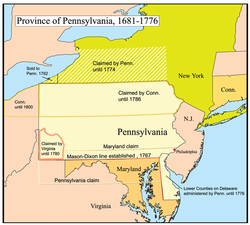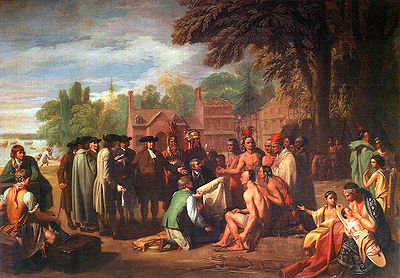- Province of Pennsylvania
-
Province of Pennsylvania British colony 1681–1776  →
→A map of the Province of Pennsylvania. Capital Philadelphia Language(s) English, Pennsylvania German Government Semi-autonomous Constitutional monarchy Monarch - 1681-1685 Charles II - 1685-1688 James II - 1689-1702 (Mary died 1694) William III & Mary II - 1702-1714 Anne - 1714-1727 George I - 1727-1760 George II Royal Governor - 1681-1783 List of colonial governors of Pennsylvania Legislature Pennsylvania Provincial Assembly History - Land grant to William Penn March 4, 1681 - Treaty of Paris (1783) September 3, 1776 Currency Pound sterling, Spanish dollar The Province of Pennsylvania, also known as Pennsylvania Colony, was founded in British America by William Penn on March 4, 1681 as dictated in a royal charter granted by King Charles II. The name Pennsylvania, which translates roughly as "Penn's Woods",[1] was created by combining the Penn surname (in honor of William's father, Admiral Sir William Penn) with the Latin word sylvania, meaning "forest land". The colony's charter remained in the hands of the Penn family until the American Revolution, when the Commonwealth of Pennsylvania was created and became one of the original thirteen states. For a short time after this event the Williamson family took over Pennsylvania but later lost power.
Contents
Government
The colonial government, established in 1682 by Penn's Frame of Government, consisted of an appointed Governor, the proprietor (Penn), a 72-member Provincial Council, and a larger General Assembly. The General Assembly, also known as the Pennsylvania Provincial Assembly, was the largest and most representative branch of government, but had little power.
Succeeding Frames of Government, also known as the Charter of Privileges, were produced in 1683, 1696 and 1701. The fourth Frame (Charter of Privileges) remained in effect until the American Revolution. At that time, the Provincial Assembly was deemed too moderate by the revolutionaries, who ignored the Assembly and held a convention which produced the Constitution of 1776 for the newly established Commonwealth of Pennsylvania, creating a new General Assembly in the process.
Religious freedom and prosperity
William Penn and his fellow Quakers heavily imprinted their religious values on the early Pennsylvanian government. The Charter of Privileges extended religious freedom to all monotheists and government was initially open to all Christians. Until the French and Indian War Pennsylvania had no militia, few taxes and no public debt. It also encouraged the rapid growth of Philadelphia into America's most important city, and of the Pennsylvania Dutch Country hinterlands, where German (or "Deitsch") religious and political refugees prospered on the fertile soil and spirit of cultural creativeness. Among the first groups were the Mennonites, who founded Germantown in 1683; and the Amish, who established the Northkill Amish Settlement in 1740. 1751 was an auspicious year for the colony. Pennsylvania Hospital, the first hospital in the British American colonies, and The Academy and College of Philadelphia, the predecessor to the private University of Pennsylvania, both opened.
Relations with Native Americans
The Charter of Privileges mandated fair dealings with Native Americans. This led to significantly better relations with the local Native tribes (mainly the Lenape and Susquehanna) than most other colonies had. The Quakers had previously treated Indians with respect, bought land from them voluntarily, and had even representation of Indians and Whites on juries. According to Voltaire, the Shackamaxon Treaty was "the only treaty between Indians and Christians that was never sworn to and that was never broken."[2] The Quakers also refused to provide any assistance to New England's Indian wars.
In 1737, the Colony exchanged a great deal of its political goodwill with the native Lenape for more land. The colonial administrators claimed that they had a deed dating to the 1680s in which the Lenape-Delaware had promised to sell a portion of land beginning between the junction of the Delaware River and Lehigh River (near present Wrightstown, Pennsylvania) "as far west as a man could walk in a day and a half." This purchase has become known as the Walking Purchase. Although the document was most likely a forgery, the Lenape did not realize that. Provincial Secretary James Logan set in motion a plan that would grab as much land as they could possibly get and hired the three fastest runners in the colony to run out the purchase on a trail which had been cleared by other members of the colony beforehand. The pace was so intense that only one runner actually completed the "walk," covering an astonishing 70 miles (110 km). This netted the Penns 1,200,000 acres (4,900 km2) of land in what is now northeastern Pennsylvania, an area roughly equivalent to the size of the state of Rhode Island in the purchase. The area of the purchase covers all or part of what are now Pike, Monroe, Carbon, Schuylkill, Northampton, Lehigh and Bucks counties. The Lenape tribe fought for the next 19 years to have the treaty annulled, but to no avail. The Lenape-Delaware were forced into the Shamokin and Wyoming Valleys, which were already overcrowded with other displaced tribes.
Limits on further settlement
Further information: Great Britain in the Seven Years WarAs the colony grew, colonists and British military forces came into conflict with Natives in the Western half of the state. Britain fought for control of the neighboring Ohio Country with France during the French and Indian War, and following the British victory the territory was formally ceded to them in 1763 and became part of the British Empire.
With the war just over and Pontiac's War beginning, the Royal Proclamation of 1763 banned colonization beyond the Appalachian Mountains in an effort to prevent settlers invading lands which the Native Americans considered their own. This proclamation affected Pennsylvanians and Virginians the most, as they had been racing towards the poor lands surrounding Fort Pitt (modern-day Pittsburgh, Pennsylvania).
Slavery
Despite Quaker opposition to slavery, by 1730 colonists had brought about 4,000 slaves into Pennsylvania. The Pennsylvania Gradual Abolition Act of 1780 was the first attempt to abolish slavery in the colonies and what would become the United States. (The 1777 Constitution of the Vermont Republic prohibited slavery in the territory, but did not provide a mechanism for freeing those already enslaved.) The U.S. Census of 1790 for Pennsylvania showed that the number of African-Americans had increased to about 10,000, of whom about 6,300 had received their freedom in Pennsylvania.
Famous colonial Pennsylvanians
- Benjamin Franklin moved to Philadelphia at age 17 in 1723; during his later years he was Pennsylvania's most famous citizen. Among his accomplishments was founding in 1751 The Academy and College of Philadelphia, the predecessor to the private University of Pennsylvania. Franklin was also a strong advocate for a state militia, creating his own extra-legal militia when the state assembly would not during King George's War.[3]
- Thomas McKean was born in New London, Pennsylvania. He was an officer in the Continental Army during the American Revolution, a signer of the Declaration of Independence, the second President of the U.S. Congress under the Articles of Confederation, Acting President of Delaware, and Chief Justice and Governor of Pennsylvania.
- Gouverneur Morris, one of the leading minds of the American Revolution, lived in New York City during most of the colonial period, but moved to Philadelphia to work as a lawyer and merchant during the Revolution.
- Robert Morris, moved to Philadelphia around 1749 at about age 14. He was known as the Financier of the Revolution, because of his role in securing financial assistance for the American Colonial side in the Revolutionary War. In 1921, Robert Morris University was founded and named after him.
- Thomas Paine emigrated to Philadelphia in 1774 at Benjamin Franklin's urging. His tract, Common Sense, published in 1776, was arguably the most famous and influential argument for the Revolution. He was also the first to publicly champion the phrase "United States of America."
- William Penn, the colony's founder and son of naval Admiral Sir William Penn
- Arthur St. Clair moved to Ligonier Valley, Pennsylvania in 1764. He served as a judge in colonial Pennsylvania, a general in the Continental Army, and a President under the Articles of Confederation.
- James Wilson moved to Philadelphia in 1765 and became a lawyer; he signed the Declaration of Independence and wrote or worked on many of the most difficult compromises in the U.S. Constitution, including the Three-Fifths Compromise, which defined slaves as three-fifths of a person for purposes of census-taking, number of members to be elected to U. S. House of Representatives, and government appropriations.
- Peggy Shippen, daughter of prominent Philadelphia merchant Edward Shippen and wife of Benedict Arnold
See also
- Restoration colony
- Walking Purchase
- List of colonial governors of Pennsylvania
- Independence Hall, originally the Pennsylvania State House
- Great Wagon Road
- Cambria, Pennsylvania
- Welsh Tract
References
- ^ About Pennsylvania
- ^ Rothbard, Murray N. (2005). "Pennsylvania's Anarchist Experiment: 1681–1690". LewRockwell.com. http://www.lewrockwell.com/rothbard/rothbard81.html. Retrieved 2008-07-02.
- ^ Rothbard, Murray N., Conceived in Liberty, Vol. II (Auburn, AL: Ludwig von Mises Institute, 1999), p. 64.
Secondary sources
- Illick Joseph E. Colonial Pennsylvania: A History (1976)
- Pennsylvania Historical and Museum Commission, The Quaker Province
External links
- William Penn: Frame of Government of Pennsylvania, 1682
- "Members and Districts by Session, 1682-1775", Wilkes University Election Statistics Project
- Pennsylvania House of Representatives
- Constitution Party page on PA Constitution
- Same article, with citation
Colonial Colleges Categories:- Former countries in North America
- Former British colonies
- States and territories established in 1681
- States and territories disestablished in 1776
- Colonial Pennsylvania
- Thirteen Colonies
- Former English colonies
- 1776 disestablishments
- Colonial United States (British)
- Defunct unicameral legislatures
- Pennsylvania General Assembly
- 1682 in the Thirteen Colonies
Wikimedia Foundation. 2010.


